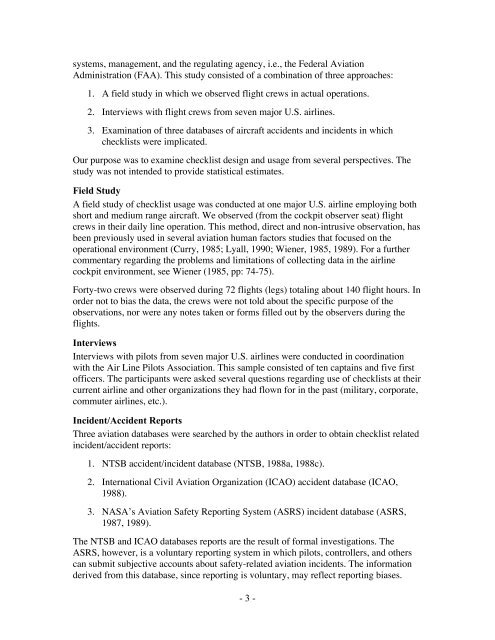COCKPIT CHECKLISTS: CONCEPTS, DESIGN, AND USE - NASA
COCKPIT CHECKLISTS: CONCEPTS, DESIGN, AND USE - NASA
COCKPIT CHECKLISTS: CONCEPTS, DESIGN, AND USE - NASA
Create successful ePaper yourself
Turn your PDF publications into a flip-book with our unique Google optimized e-Paper software.
systems, management, and the regulating agency, i.e., the Federal AviationAdministration (FAA). This study consisted of a combination of three approaches:1. A field study in which we observed flight crews in actual operations.2. Interviews with flight crews from seven major U.S. airlines.3. Examination of three databases of aircraft accidents and incidents in whichchecklists were implicated.Our purpose was to examine checklist design and usage from several perspectives. Thestudy was not intended to provide statistical estimates.Field StudyA field study of checklist usage was conducted at one major U.S. airline employing bothshort and medium range aircraft. We observed (from the cockpit observer seat) flightcrews in their daily line operation. This method, direct and non-intrusive observation, hasbeen previously used in several aviation human factors studies that focused on theoperational environment (Curry, 1985; Lyall, 1990; Wiener, 1985, 1989). For a furthercommentary regarding the problems and limitations of collecting data in the airlinecockpit environment, see Wiener (1985, pp: 74-75).Forty-two crews were observed during 72 flights (legs) totaling about 140 flight hours. Inorder not to bias the data, the crews were not told about the specific purpose of theobservations, nor were any notes taken or forms filled out by the observers during theflights.InterviewsInterviews with pilots from seven major U.S. airlines were conducted in coordinationwith the Air Line Pilots Association. This sample consisted of ten captains and five firstofficers. The participants were asked several questions regarding use of checklists at theircurrent airline and other organizations they had flown for in the past (military, corporate,commuter airlines, etc.).Incident/Accident ReportsThree aviation databases were searched by the authors in order to obtain checklist relatedincident/accident reports:1. NTSB accident/incident database (NTSB, 1988a, 1988c).2. International Civil Aviation Organization (ICAO) accident database (ICAO,1988).3. <strong>NASA</strong>’s Aviation Safety Reporting System (ASRS) incident database (ASRS,1987, 1989).The NTSB and ICAO databases reports are the result of formal investigations. TheASRS, however, is a voluntary reporting system in which pilots, controllers, and otherscan submit subjective accounts about safety-related aviation incidents. The informationderived from this database, since reporting is voluntary, may reflect reporting biases.- 3 -
















